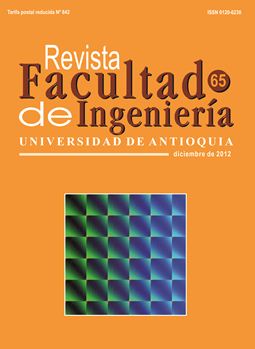Study of major variables for the establishment of electrolytic plasma at low power
DOI:
https://doi.org/10.17533/udea.redin.14171Keywords:
high-voltage electrolytics, surface nanostructuring, nanograins, conductivity, electrolytic plasmaAbstract
In this work, exploratory tests were carried out aimed at studying the variables that allow obtaining electrolytic plasma (PE) at low cell voltages and / or at low energy. For this, the electrolyte effects were studied, obtaining conditions that allow PE to be generated at less than 250 Vdc. The results show that the use of inert solutions with 1:12 or numerically lower and temperatures close to boiling correspond to the optimal ones to obtain plasma at low voltages. The nanograin electrode between 14 and 24 nm.
Downloads
References
P. Gupta, G. Tenhundfeld, E. Daigle, D. Ryabkov. “Electrolytic plasma technology: science and engineering- an overview”. Surf Coat Tech. Vol. 201. 2007. pp. 8746. DOI: https://doi.org/10.1016/j.surfcoat.2006.11.023
E. Meletis, X. Nie, F. Wang, J. Jian. “Electrolytic plasma processing for cleaning and metal-coating of steel surface”. Surf Coat Tech. Vol. 150. 2002. pp. 246- 256. DOI: https://doi.org/10.1016/S0257-8972(01)01521-3
T. Paulmier, J. Bell, P. Fredericks. “Deposition of nano-crystalline graphite films by cathodic plasma electrolysis”. Thin Solid Films. Vol. 515. 2007. pp. 2926-2934. DOI: https://doi.org/10.1016/j.tsf.2006.08.027
G. Sundararajan, L. Rama Krishna. “Mechanisms through the MAO coating technology”. Surf Coat Tech. Vol. 167. 2003. pp. 269-277. DOI: https://doi.org/10.1016/S0257-8972(02)00918-0
J. Gao, A. Wang, Y. Li, Y. Fu, J. Wu, Y. Wang, Y. Wang. “Synthesis and characterization of superabsorbent plasma”. React Funct Polym. Vol. 68. 2008. pp. 1377- 1383. DOI: https://doi.org/10.1016/j.reactfunctpolym.2008.06.018
Q. Lu, J. Yu, J. Gao. “Degradation of 2,4-dichlorophenol .J Hazard Mater. Nº. 136. 2006. pp. 526-531. DOI: https://doi.org/10.1016/j.jhazmat.2005.11.001
H. Kellogg. “Anode Effect in Aqueous Electrolysis”. J Electrochem Soc. Vol. 97. 1950. pp. 133. DOI: https://doi.org/10.1149/1.2777980
A. Hickling, M. Ingram. “Contact glow-discharge electrolysis”. Trans Faraday Soc. Vol. 60. 1964. Pp. 183 DOI: https://doi.org/10.1039/tf9646000783
D. Slovetskii, S. Terent’ ev. “Parameters of an Electric Discharge in Electrolytes and Physicochemical Processes in an Electrolyte Plasma”. High Energ Chem. Vol. 37. 2003. pp. 310. DOI: https://doi.org/10.1023/A:1025752813422
C. Sillen, E. Barendrecht, L.anssen, S.van Stralen. . Int J Hydrog Energ. Vol. 7. 1982. pp. 577. DOI: https://doi.org/10.1016/0360-3199(82)90038-6
M. Boinet, D. Marlot, J. Lenain, S. Maximovitch, F. Dalard, R. Nogueira. “First results from coupled acousto-ultrasonics and electrochemical noise techniques applied to gas evolving electrode”. Electrochem Commun. Vol. 9. 2007. pp. 2174-2178. DOI: https://doi.org/10.1016/j.elecom.2007.05.026
E. Parfenov, A. Yerokhin, A. Matthews: “Frequency response studies for the plasma electrolytic oxidation process”. Surf Coat Tech. Vol. 201. 2007. pp. 8661- 8670. DOI: https://doi.org/10.1016/j.surfcoat.2007.04.044
A. Maximov, A. Khlustova. “Optical emission from plasma discharge in electrochemical systems applied . Surf Coat Tech. Vol. 201. 2007. pp. 8782-8788. electrolysis”. Electrochim Acta. Vol. 56. 2010. pp. 925. DOI: https://doi.org/10.1016/j.surfcoat.2007.02.042
X. Ji, X. Wang, J. Yue, Y. Cai, H. Zhang. “ The effect of electrolyte constituents on contact glow discharge electrolysis”. Electrochim Acta. Vol. 56. 2010. Pp. 925. DOI: https://doi.org/10.1016/j.electacta.2010.09.079
Downloads
Published
How to Cite
Issue
Section
License
Copyright (c) 2018 Revista Facultad de Ingeniería

This work is licensed under a Creative Commons Attribution-NonCommercial-ShareAlike 4.0 International License.
Revista Facultad de Ingeniería, Universidad de Antioquia is licensed under the Creative Commons Attribution BY-NC-SA 4.0 license. https://creativecommons.org/licenses/by-nc-sa/4.0/deed.en
You are free to:
Share — copy and redistribute the material in any medium or format
Adapt — remix, transform, and build upon the material
Under the following terms:
Attribution — You must give appropriate credit, provide a link to the license, and indicate if changes were made. You may do so in any reasonable manner, but not in any way that suggests the licensor endorses you or your use.
NonCommercial — You may not use the material for commercial purposes.
ShareAlike — If you remix, transform, or build upon the material, you must distribute your contributions under the same license as the original.
The material published in the journal can be distributed, copied and exhibited by third parties if the respective credits are given to the journal. No commercial benefit can be obtained and derivative works must be under the same license terms as the original work.










 Twitter
Twitter